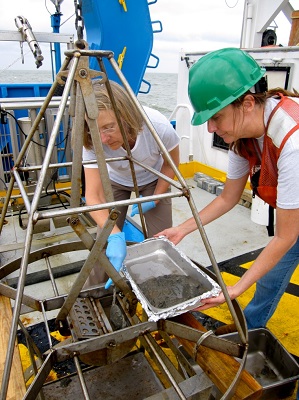Dredged Material Testing and Evaluation for Permitting under the Marine Protection, Research and Sanctuaries Act

Dredged material proposed for permitting under the Marine Protection, Research and Sanctuaries Act (MPRSA) is evaluated and tested to ensure that the material will not adversely affect human health and the marine environment. The sediments dredged from our nation’s waterways sometimes are contaminated by historic chemical pollutants. If biologically available, such contaminants may be ingested or absorbed by marine organisms, resulting in toxicity (e.g., death) or bioaccumulation (accumulation of pollutants in the organism’s tissues), which, in turn, exposes other organisms in the food web and ultimately humans when contaminated seafood is eaten.
Evaluation of dredged material under the MPRSA relies on standardized testing using biological organisms (bioassays). The purpose of the evaluation procedures is to ensure efficient and reliable protection against toxicity and bioaccumulation that otherwise may impair the marine environment or human health.
Ocean Testing Manual
In 1991, the EPA and U.S. Army Corps of Engineers (USACE) jointly published the Ocean Testing Manual, a national testing manual for the evaluation of dredged material proposed for permitting under the MPRSA (also known as the Green Book). Under section 103 of the MPRSA, any proposed disposition of dredged material into ocean waters must be evaluated through use of the EPA’s marine protection criteria (40 CFR 227-228). The Ocean Testing Manual provides guidance for sampling, testing, and analysis of water, sediment and tissue to evaluate the environmental acceptability of dredged material proposed for permitting under the MPRSA. Uncharacterized materials are prohibited from permitting under the MPRSA (40 CFR 227.5(c)). Therefore, the EPA and the USACE review sampling and analysis plans to ensure that each project’s sediments are appropriately characterized.
Regional Implementation Manuals
The EPA Regional and The USACE District Offices work together to develop Regional Implementation Manuals that provide regional refinements to the national guidance, such as identifying contaminants of concern for particular harbors and recommending specific species of organisms to be used in testing of dredged material.
Region 1:
Region 2:
Guidance for Performing Tests on Dredged Material Proposed for Ocean Disposal
Region 3:
Region 4:
Region 6:
Region 9:
Local regional guidance is provided by San Francisco Bay’s Long Term Management Strategy (LTMS) and its Dredged Material Management Office (DMMO) for USACE San Francisco District projects and by the Southern California Dredged Material Management Team (SC-DMMT) for USACE Los Angeles District projects. For all other dredging projects involving ocean disposal, local sediment testing guidance is provided on a case-by-case basis, using the Ocean Testing Manual (Green Book).
Region 10:
Sediment Evaluation Framework for the Pacific Northwest
Related National Guidances
Additional related guidances, including scientific methodologies and environmental evaluation and reporting techniques, are provided in the following documents:
- Methods for Collection, Storage and Manipulation of Sediments for Chemical and Toxicological Analyses
- Quality Assurance/Quality Control Guidance for Sampling and Analysis of Sediments, Water, and Tissues for Dredged Material Evaluations
- Guidance for Quality Assurance Project Plans
- Guidance for the Data Quality Objectives Process
Evaluation of dredged material for inland disposal under the Clean Water Act relies on the use of physical, chemical and/or biological tests to determine acceptability of material to be disposed. The Inland Testing Manual is national guidance which provides best available methods for this CWA evaluation. To learn more about dredged material evaluation under the Clean Water Act, please visit Section 404 of the CWA Web page.
For more information about how sediment testing is used in the issuance of MPRSA permits and, in the case of federal navigation projects, authorizations for dredged material, please see MPRSA Dredged Material Permits Web page.
